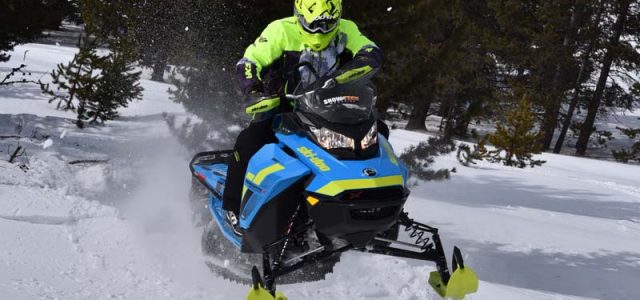
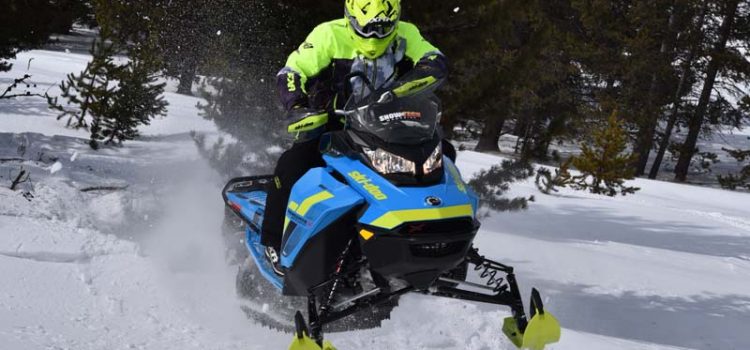

Not quite a mountain sled, not quite a trail sled, rather a new breed of extreme crossover – getting closer and closer to that one sled that can truly do it all. If you’re a true 50/50 on-trail/off-trail crossover rider, you want this sled. Really bad. It’s that good. After 1,000 miles, we know. Beg, borrow, steal, trade, whatever it takes to get one. You will not regret it. We didn’t always feel that way about the new Gen 4 Backcountry X. From prototype to production specification it took plenty of debate, changing specs and refining the calibration. The end result is very, very close to perfect – if there is such a thing.

The Sled – 2018 Ski-Doo Renegade Backcountry X 850
Crossover riding is getting bigger and bigger as riders realize the wider range of conditions these sleds excel at, giving them the ability to master everything they might encounter – groomed trails, deep snow, off-trail forest roads, cross country riding, and even some mild mountain riding. But, should this machine be a trail sled with better flotation, or a deep snow sled with better trail handling? Exactly where should this line be drawn, or do we even have to draw the line? Can’t we have it all, or almost all of it, in one single machine?
For 2018 Ski-Doo is rolling up their sleeves and taking another stab at delivering an even better crossover sled with their all-new Backcountry & Backcountry X models. Yes, they are now Gen 4 platform 850s in the 146” track length, but with a new cMotion rear suspension. Not a tMotion (long track), not an rMotion (short track), but a blend of the character of each. Here we find tipped up rails for more responsive handling on packed trails, yet it is an un-coupled rear arm for nice transfer and lift in the off-trail environment. The geometry and motion ratio is similar to the tMotion, but the arms are fixed like the rMotion and do not pivot like they do on a tMotion. Add to this full-width track rods (NOT a Flex Edge track) for added stability and a crossover-specific RAS 3 front suspension and we have a pretty trick crossover machine. Not quite a mountain sled, not quite a trail sled, rather a new breed of extreme crossover – getting closer and closer to that one sled that can truly do it all.
How about the previous versions of the BCX, on the REV-XS platform? The previous Backcountry sleds were deemed by many to be too off trail oriented with the Flex Edge track and pivoting tMotion rear suspension, as well as the front end geometry. Riders found the Backcountry 146” REV-XS models from the past two years were still too much of a Summit with a shorter track and lower lugs, where they wanted more of a Renegade with a longer track and better handling. Remember, the sled is called a “Renegade” Backcountry, not a “Summit” Backcountry. What’s the difference? The on-trail stability. Going back to a standard track and making the front and rear arms rigid on this new Gen 4 BCX for 2018 gives us a whole lot more stability, as does the hybrid RAS 3 geometry. Even the seat is from a Renegade, trying to blend the character between the two disciplines.


Set to 38” wide the sled is still quite agile, better suited if you do more off trail than on trail riding. If you prefer more stability and more of a 50/50 character, you can pull the ski bolts and swap the spacers around for a 40” ski stance, adding to the stability and on-trail manners.
Another key feature is the adjustable front end width. At 38.4” wide the sled is still quite agile, better suited if you do more off trail than on trail riding. If you prefer more stability and more of a 50/50 character, you can pull the ski bolts and swap the spacers around for a 40.2” ski stance, adding to the stability and on-trail manners. Does it work as good on the trail as a Renegade 137”? Not quite, this is an un-coupled rail. Does it work as good as a Summit 146” off-trail? Not quite, the standard lug height is 1.6” but you can get an optional 2” PowderMax track. The key here is it will work far better in deep snow than a Renegade 137”, and it will work far better on-trail than a Summit 146”. The goal here is to give you as much of a deep snow sled as possible, while still maintaining the ability to be used for extended distances as a trail sled, specifically in the handling and hyfax/cooling departments.
Instead of being an expert ride in one place or the other, it bridges the gap and gives us a really good sled across a wider set of conditions. For all of the riders who have been buying a mountain sled to ride at low elevation, most every one of them would be better suited with a sled like the Backcountry if they do any amount of trail riding. For the guys looking for the elusive 50/50 crossover sled, this one is getting closer and closer to that Holy Grail.
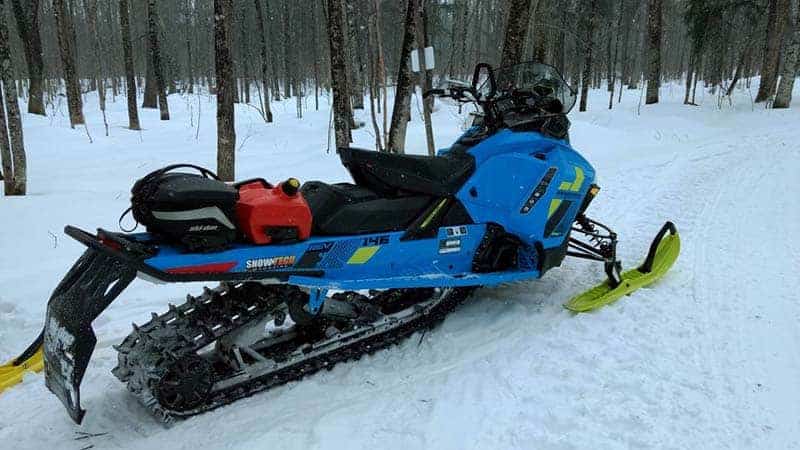
“We weren’t totally impressed the first two times we rode these machines as prototypes. Would the third time be the charm?”
1,000 Mile SnowTech Test Report – 2018 Ski-Doo Renegade Backcountry X 850
Long-time readers of SnowTech know how we have been promoting the virtues of the crossover sleds ever since their introduction. In a way, we have been carrying the torch for crossover sleds, being one of their strongest advocates. We even started the habit of using ratios to better describe a sled’s capability split of on-trail and off-trail performance.
With the 2018 Backcountry X, Ski-Doo’s goal was to create the premier 50/50 crossover sled, combining precise and responsive trail handling with agile and effortless off-trail maneuverability, all while delivering industry-leading ride quality and comfort. This is exactly what they told us when we visited the Ski-Doo factory in January for their 2018 new model introduction.
Problem was, when we went out and rode several of the 2018 prototype versions of the Backcountry X sleds, what we were riding did not match up with what we had just been told. At that time, the machines were still far more of a Summit and much less of a Renegade, a capable deep snow machine but with trail manners that were, well, lacking the title of being called a 50/50 crossover. As much as we wanted to like the sled, we felt it had missed the target.
After that initial day of riding the 2018 BCX prototypes, we had lengthy discussions with Ski-Doo about how concerned we were that the sleds we rode were not what they were telling us they would be. They had put more emphasis on the off-trail aspects, we were looking for more on-trail stability. As with many brand new models, the exact calibration and build specifications are being finalized well into the Spring, so it was not only a matter of trying to make the new BCX as good as possible, but to have the performance delivered match the performance being promoted and promised.
So, what was the issue? The sled simply acted too narrow, too tippy, too agile, very active and demanding while trying to ride it down a trail. It acted like the front arm (of the rear suspension) had too much tension, like there was too much pressure at the front of the rails. You just couldn’t get the front end to plant and rail around a corner like we felt it should if we were to be calling it a 50/50 crossover. It was too much of a Summit, not enough of a Renegade. I really didn’t want to ride it on the trail, it took too much effort and was lacking my confidence.
Ski-Doo calibration engineers didn’t like what they were hearing, but they listened, took notes, and asked questions. We discussed it, and discussed it again. They started making changes immediately, as we would be riding the next rendition just a few short weeks later.
Our next test session with what were now pre-production prototypes was four weeks later in late February. Here we found the cMotion rear suspension to be working extremely well, very close to an rMotion in ride quality and bump compliance, actually better in some situations since it is uncoupled, but with surprisingly little transfer for an uncoupled rail. But what really mattered to us was how the front end acted, and how the sled handled. It had progressed and was much closer to the target, but still just not quite perfect. You could tell it had changed for the better, but the original observation of it being more of a Summit and less of a Renegade still held true. It was really good, but just not quite what we wanted. We still expected something different, for a 50/50 crossover sled.
At that point, we had to ask ourselves if our expectations were fair? What exactly should we be expecting of a sled with a 146” track length and a 1.6” lug height? If a sled is truly a 50/50, how much mountain sled capability should it have and how much trail sled capability should it have? We struggled with this for a while, wondering if we were actually looking for a sled that wasn’t a 50/50, looking for a sled that was more of a trail sled than it was an off trail sled. Maybe Ski-Doo wanted their 50/50 to be more of an off trail sled than what we wanted.
Ski-Doo had originally told us we would be getting a pre-production prototype sled in mid-February for us to do our own testing with, but with all of the calibration changes this delivery was delayed. It wasn’t until March that our test unit arrived, and by that time the decent snow in our area was shrinking fast – very fast. We high-tailed it up to our test grounds in the U.P. of Michigan and spent a week chasing various snow conditions, from the Keweenaw in the west to Whitefish Point in the east. By the end of the week we had logged just a whisker shy of 1,000 miles on this exact machine, and when combined with the miles we had logged on the other test units in January and February we could accurately claim having well over 1,000 miles on the 2018 Ski-Doo Backcountry X 850 by the third week of March.


We spent a week chasing various snow conditions in the U.P. of Michigan, from the Keweenaw in the west to Whitefish Point in the east. By the end of the week we had logged just a whisker shy of 1,000 miles on this exact machine.
We knew that several changes had been made along the way – the sway bar had been changed from being a Summit sway bar to a Renegade sway bar. The front end width was going to come delivered at 40.2” for greater stability, not the narrower 38.4” for agility, but could still be switched by the end user to match their preferences. The spindles were unique, having been a Summit design but then changed to being closer to a Renegade spindle, but not quite, so the end piece is unique to the BCX. The calibration of the front shock had been refined, as had the components in the front suspension. A dual-rate center spring helped to let the front arm settle in more, adding to more stable front end manners.
When we picked the sled up from the dealer, we weren’t all that excited to have to ride it for the entire week, knowing it might be a handful to keep the skis on the ground and a beast to get around some of the corners. We had eight different sleds to ride that week, so we really didn’t want to be wasting time on a sled that didn’t work all that good.
Wow, were we wrong. It truly was a work in progress, with each rendition getting better and better, and this time around they flat out nailed it. The specification on the test sled we received is what is intended for the production units. Ski-Doo had moved to a set-up that was more trail friendly but still worked great off trail – based in part on feedback from sources like us.
First time out, actually first ten minutes into it, you notice how smooth and seamless the power delivery was. The clutching, gearing, traction, total power delivery was more refined than either of our 2017 E-TEC 850s. No issues here, the drivetrain calibration was nailed. Often times with a crossover sled we find the machine to be geared too low for our liking to use as a trail sled, running at a higher RPM level rolling down a trail, using too much fuel and just plain being a mismatch for the application. Not this time, it felt like a Renegade, maybe geared ever so slightly lower to match the longer track with taller lugs.
Even more instant was the observation of how light the sled felt, still being quick to respond and agile, but it’s that responsiveness that makes it feel so light. It probably isn’t as light as it feels, but it projects that character. Our other sleds felt wide and heavy in comparison, this one felt narrow and agile. You knew it was a long track, but it didn’t push like the earlier versions. It didn’t lift the skis abruptly, rather controlled and predictable. That also meant it wasn’t dropping the skis back down abruptly on deceleration either.
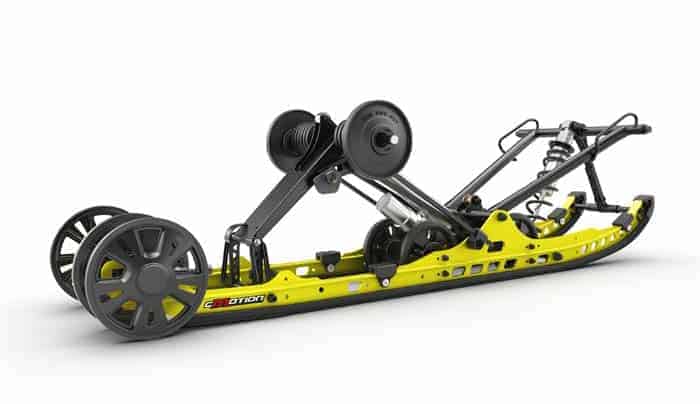
The new cMotion rear suspension is the real deal for true 50/50 crossover performance.
The cMotion rear suspension was nothing short of amazing. We had wondered if it would be good enough, close enough to an rMotion, but wonder no more. It is so close to an rMotion, maybe even better, it will blow your mind. Many of our riders stated they felt it was even smoother, rode even better than the 2017 rMotion sleds. It is a complete and total non issue for those wondering if it would act too much like a tMotion. There is no pivot, there is no FlexEdge track, and it goes through the bumps with incredible smoothness and compliance. This was a big surprise for us in how well the cMotion worked for us over the course of the week, with riders of all weights. Rarely bottomed, straight tracking, so much smoother than any other crossover sled, we have no issues here at all. Well, we question if the rear of the rails are tipped up enough, as it is very subtle and transfer is much less than one would expect, but at the end of the day the sled remains completely predictable so we’re OK with it. Bottom line, the new cMotion rear suspension is the real deal, it should not disappoint you in any way. And, it is eleven pounds lighter than a 137” rMotion? Not sure how, but that is crazy impressive all by itself.
But, what about the on-trail handling? If we’re going to call this a 50/50 trail sled with a straight face, it had to handle better than what we had ridden before. That has been the 500-pound gorilla for us all along.
Well, our exact test sled definitely worked better for us than the earlier versions. Granted, we were able to spend the time with this unit to calibrate it specifically to our liking, but it was as simple as setting the torsion springs and rear shock damping. No longer does the machine feel tall in the center, no longer does it feel like there is too much pressure at the front of the rails. No longer does the track push the skis through the corners. The DS2 skis hook up and follow their line, even if the inside ski lifts slightly, it is a slower, more controlled lift than with the previous calibrations. We suspect the sway bar is now softer, and that the front arm had been lightened up as we now had ski pressure and grip to corner with greater confidence and speed. Our test sled goes around a corner WAY better than any of the earlier versions we had ridden. Yes, it acts narrower and (yes) it will take a bit more effort (leaning) to keep the skis on the ground compared to wider trail sled, but this is a 50/50 crossover sled. A TRUE 50/50 crossover sled, with a 146” track.

Yes you can ride it on trail, even if it is for 1,000 miles. That is the point. We rode the 2018 BCX for 1,000 miles on groomed trails, going left and right on trail and through bumps for over 200 miles per day, day after day. No way in hell would we trade this sled for any other, knowing now how well it works across such a wide range of conditions.
We still believe it is more accurate to call it a deep snow sled that now handles extremely well on trail, more so than it is a trail sled with a long track. Yes, you can ride it off trail, yes you can ride it on trail, even if it is for 1,000 miles. That is the point. We rode the thing for 1,000 miles on groomed trails, going left and right and through bumps at high speeds for over 200 miles per day, day after day. No way would we trade this sled for any other, not for how and where we ride. Actually, we do more deep snow riding on forest roads and trail riding with less actual off trail riding. We technically are not doing true 50/50 riding, probably more accurately 60/40 on/off, but we would still want the BCX for how good it works off trail, the awesome rear suspension and trail handling that is perfectly acceptable, albeit a bit more active than a trail sled with a wider front end would be.
The off trail capability and responsiveness was never the question or issue with the BCX, the Gen 4 platform is agile and responsive and this one is no different, easy to tip up, even if you never do any sidehilling. Ski-Doo wanted this sled to maintain the agility and tip-up capability that has made the Gen 4 platform so famous in the west, and it’s in there, whether you need it or not. As the calibration shifted towards slightly more stability for the trail rider, the sled remains very agile and capable in deep snow riding as well.
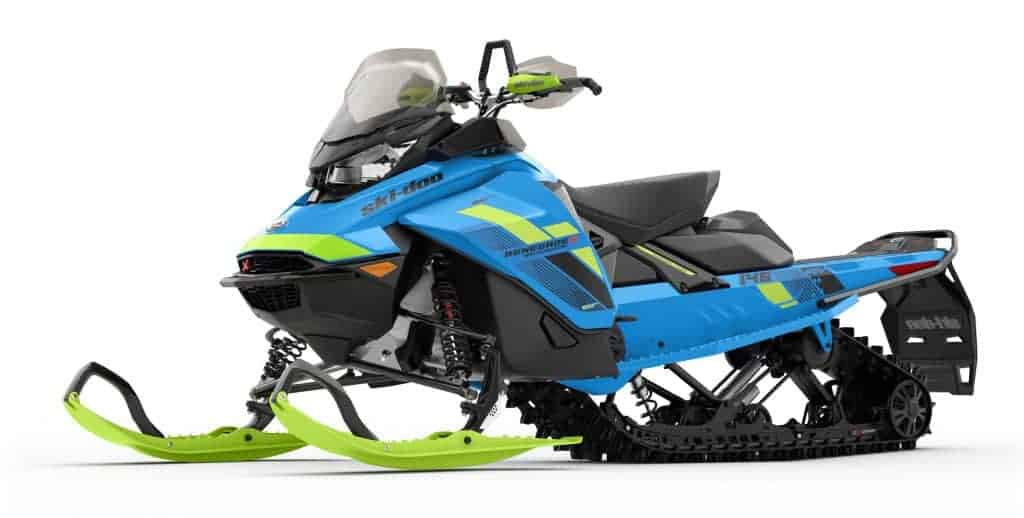
We know of a bunch of riders who buy an actual mountain sled to have the deep snow capability, but then complain about how it handles and how they burn up the hyfax or throw lugs because they are riding it like a trail sled far too often. The BCX is a machine that gives us a wider range of conditions that it will excel at. For those who think the 1.6” Cobra just isn’t enough, consider the 2” PowderMax track option. Tweaks the ratio slightly more off trail and takes away from the ability to ride it on hardpack for extended periods, but the overall complete package is a perfect match for those looking for a sled that handles the deep snow far better than a 137” machine, or those looking for a deep snow machine with top-notch bump performance and ride quality with very good trail handling characteristics.
So if you are a TRUE 50/50 rider, one who truly spends equal time off trail with your time on trail, this sled is freakin’ awesome. In the discussion with all of our test riders who spent time on it, we do believe that riders who spend more time on trail than off trail might still be happier with the more planted front end and handling character of something like the Renegade X-RS or Renegade X. But, if 137” just isn’t long enough then the new BCX will rock your world and redefine what a single snowmobile could possibly be capable of.
Want more articles and content like this? Subscribe to SnowTech Magazine and get all 5 issues delivered right to your door! Like our facebook page to keep up with us online.





